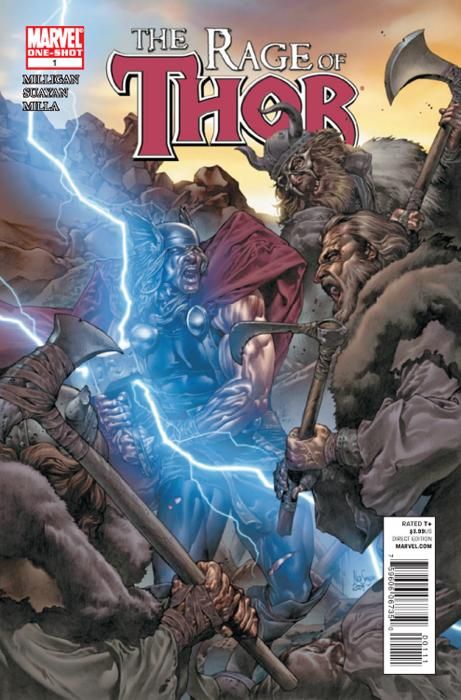A sequel to last year's "The Trial of Thor," "The Rage of Thor" picks up on Thor's anger at not only being falsely accused of murdering innocents, but that his friends and father believed him to be guilty. Unlike "The Trial of Thor," this book has a feel more in sync with what Asgard has been shown to be. While that book used pseudo-science in the form of magic, this one is rooted in the relationship between Thor and Odin, relying on their problems and emotions to drive the story with a healthy dose of brutal, barbaric violence thrown in for good measure.
Beginning with father and son fighting against Surtur together, Odin reminds Thor of what happened, suggesting that it was a good thing, bringing the issue to a head. You get the impression that Thor was content to let it slide, until Odin had to suggest that being falsely accused of murder and having his friends and family believe it, was a needed dose of humility for Thor. From that point, Thor grows more and more incensed, eventually leaving Asgard for Earth, which, of course, is a problem for Asgard since Thor's absence means that the balance of power shifts to Surtur in battle.
The unstated irony of this story is that Odin continually refers to Thor's need for humility and, in the process, puts Thor into a position where he is Asgard's only hope. Milligan taps into the competition between father and son, using that as the driving point for their conflict. Odin sees that his son is his rival in strength and power, so he pushes him down needlessly, driving Thor away until it's essential that he return. It's a pattern that we've seen numerous times before, but Milligan does well. By also showing us Thor's life as Tor, a regular human, we see him happy and content in a way that he rarely is in Asgard. Thor even critiques Asgardian life harshly late in the issue in a way that hasn't been done before, giving the character an unseen dimension.
Mico Suayan's art is a good match for Milligan's writing. It has a strong, powerful, exaggerated quality to it. His men are bulging with muscles, looking like they stepped off the cover of a fantasy novel or out of a "Conan" story. While the look is right, his actual figure work and drawings are awkward at times. Panels look cramped with characters contorted to fit within the borders or posed in a manner that doesn't look natural. He does capture the emotion and passion of the characters well; his Thor shifts between stoic silence and obvious rage.
Marvel's string of "Thor" one-shots showing the character in the times before he became the superhero most are familiar with provide an interesting subtext to the character, focusing on his harsher roots. Milligan writes that version of the character well, delivering a sequel book with Mico Suayan that manages to outdo the first by quite a bit.

